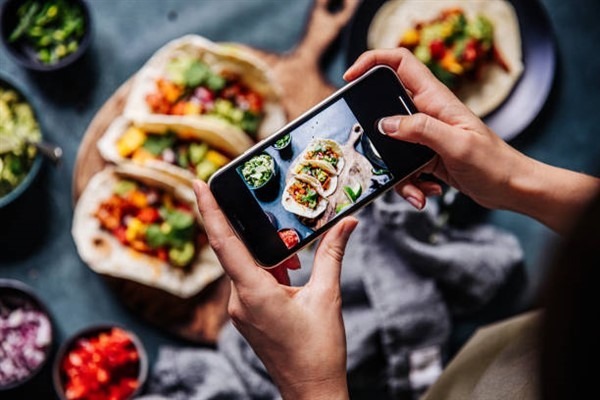Introduction:
In the digital age, where food has become a passion and a lifestyle, becoming a food blogger is an exciting venture. Whether you’re passionate about cooking, dining out, exploring culinary delights or you are just a Foodie, the world of food blogging offers a platform to share your experiences, recipes, and expertise with a global audience. In this comprehensive guide, we will explore how to become a food blogger, from defining what a food blogger is to building a successful blog, growing your audience, and monetizing your passion for all things culinary.

What Is a Food Blogger?
Before we dive into the practical aspects of becoming a food blogger, let’s start by understanding what a food blogger is and their role in the culinary world.
A. Definition and Role of a Food Blogger:
A food blogger is an individual who creates and maintains a blog focused on the subject of food. This can encompass a wide range of niches within the culinary realm, such as recipe bloggers, restaurant reviewers, dietary-focused bloggers (e.g., vegan, gluten-free), and more. Food bloggers share their love for food, culinary experiences, and expertise with their readers. They often use a combination of written content, photographs, and sometimes videos to engage and inspire their audience.
B. The Various Niches Within Food Blogging:
- Recipe Bloggers: These bloggers create and share original recipes, often accompanied by step-by-step instructions and mouthwatering food photography.
- Restaurant Reviewers: Bloggers in this niche dine out at various establishments and provide detailed reviews of their experiences, including insights into the food, service, ambience, and overall dining experience.
- Dietary-Focused Bloggers: Some food bloggers cater to specific dietary preferences or restrictions, such as vegan, vegetarian, paleo, gluten-free, and more. They offer valuable recipes, tips, and advice to readers with similar dietary needs.
C. The Impact and Influence of Food Bloggers in the Culinary World:
Food bloggers have become influential figures in the culinary world. They have the power to shape food trends, inspire home cooks, and even influence restaurant choices. Many food bloggers have successfully turned their passion into a full-time career, collaborating with brands, chefs, and food-related businesses. Their influence is evident in the growing popularity of food-related content across social media platforms, where beautifully styled food photos and engaging videos are shared and celebrated.
1) Define Your Niche
Choosing a niche is the first crucial step in becoming a successful food blogger. Your niche defines the focus and direction of your blog. Here’s what you need to consider:
A. The Importance of Choosing a Niche:
Selecting a niche is essential for several reasons. It helps you define your target audience, create focused and relevant content, and stand out in the vast world of food blogging. When you have a niche, you can establish yourself as an expert in that particular area and build a dedicated readership.
B. Explore Different Food Blogging Niches:
- Recipe Blogging: This niche focuses on creating and sharing original recipes. You can specialize in various types of cuisine, cooking methods, or dietary preferences.
- Restaurant and Food Reviews: As a reviewer, you’ll visit restaurants and food establishments, sharing your experiences and critiques.
- Dietary and Health-Focused Blogging: This niche caters to readers with specific dietary needs, such as gluten-free, vegan, keto, or paleo.
- Culinary Travel: If you’re passionate about exploring the world through food, consider a niche centred on culinary travel. Share your adventures, recipes, and tips for food-related travel.
C. Selecting a Niche That Aligns With Your Passion and Expertise:
Your chosen niche should align with your passion and expertise. If you love experimenting with plant-based recipes, a vegan food blog might be the perfect fit. If you’re a connoisseur of fine dining, a restaurant reviewing blog could be your calling. Your passion and knowledge will shine through in your content, making it more authentic and relatable to your readers.

2) Create Your Blog
Once you’ve defined your niche, it’s time to set up your food blog. This step involves selecting a blogging platform, choosing a domain name, designing an appealing blog layout, and handling technical considerations.
A. Choosing a Blogging Platform:
Selecting the right blogging platform is a critical decision. Popular platforms for food blogging include WordPress, Blogger, and Squarespace. Each has its own set of features and customization options, so choose the one that aligns with your needs and technical expertise.
B. Selecting a Domain Name:
Your domain name is your blog’s web address. It should be memorable, relevant to your niche, and reflect your blog’s identity. Keep it concise and easy to spell, as it will be the first thing your readers see. Consider using domain name generators to brainstorm ideas.
C. Designing an Appealing and User-Friendly Blog Layout:
The layout and design of your blog play a significant role in attracting and retaining readers. Choose a clean and visually appealing template that complements your niche. Ensure that the layout is user-friendly, with easy navigation, clear headings, and mobile responsiveness.
D. Setting Up Hosting and Technical Considerations:
To make your blog accessible on the internet, you’ll need web hosting. Several hosting providers offer hosting plans for bloggers. Additionally, consider technical aspects such as securing your blog with an SSL certificate, optimizing for page speed, and installing essential plugins to enhance functionality.
3) Develop Quality Content
Creating high-quality content is the heart and soul of your food blog. This step involves planning your content strategy, writing engaging and informative posts, focusing on food photography, and possibly incorporating video content.
A. Planning Your Content Strategy:
Determine the type of content you’ll create and how often you’ll publish. A content calendar can help you stay organized and maintain consistency. Consider seasonal and trending topics related to your niche.
B. Writing Engaging and Informative Posts:
Your blog posts should be well-researched, well-written, and engaging. Use your unique voice and storytelling skills to connect with your readers. Include detailed recipes, cooking tips, and personal anecdotes to make your content relatable.
C. The Significance of Food Photography:
Exceptional food photography is crucial for a food blog. Invest in a good camera, experiment with lighting, and learn the basics of food styling. High-quality, appetizing images will entice your readers and add visual appeal to your blog.
D. Incorporating Video Content:
Video content is increasingly popular in the food blogging world. Consider creating recipe videos, kitchen tutorials, or behind-the-scenes content. Platforms like YouTube, TikTok, and Instagram Reels are great for sharing video content.

4) Building an Audience
Building an audience is an ongoing process. It involves actively promoting your blog, utilizing social media and other online platforms, and engaging with your audience through comments and social interactions.
A. Strategies for Promoting Your Food Blog:
- Share your blog posts on social media platforms.
- Collaborate with other bloggers and influencers.
- Submit your recipes or articles to food-related websites.
- Attend food-related events and networking opportunities.
B. Utilizing Social Media and Online Platforms:
Leverage social media platforms such as Instagram, Pinterest, Facebook, Twitter and YouTube to share your content and engage with your audience. Use hashtags and visually appealing images to increase your reach.
C. Engaging with Your Audience Through Comments and Social Interactions:
Respond to comments on your blog and social media. Engage with your readers by asking questions, conducting polls, and encouraging them to share their thoughts and experiences. Building a sense of community around your blog is vital for long-term success.
5) Monetization and Partnerships
As your food blog gains traction, you can explore monetization opportunities. This step covers ways to make money through your blog, such as ads, affiliate marketing, sponsored posts, and building partnerships with brands and restaurants.
A. Ways to Monetize Your Food Blog:
- Ads: Incorporate display ads through platforms like Google AdSense to generate revenue based on ad impressions and clicks.
- Affiliate Marketing: Promote products and services related to your niche and earn a commission for every sale made through your affiliate links.
- Sponsored Posts: Collaborate with brands and write sponsored content that aligns with your blog’s niche and audience.
- Sell Your Own Products: Create and sell digital products, such as e-books or cooking guides, directly to your readers.
B. Building Partnerships with Brands and Restaurants:
Establishing partnerships with relevant brands, restaurants, and food-related businesses can be a lucrative venture. Reach out to potential collaborators, or wait for them to approach you once your blog gains credibility and a substantial following.
C. Legal and Ethical Considerations in Sponsored Content:
Be transparent with your audience when creating sponsored content. Disclose any paid partnerships or affiliate relationships to maintain trust and transparency.
6) Growing Your Brand
Successful food bloggers often become influential figures in the culinary world. This step covers strategies for enhancing your food blogger brand, networking, and collaborating with other bloggers and influencers.
A. Strategies for Enhancing Your Food Blogger Brand:
- Stay consistent with your niche and content style.
- Develop a unique and memorable brand identity.
- Continuously improve your photography and writing skills.
- Engage with your audience through email newsletters and social media updates.
B. Networking and Collaborating with Other Bloggers and Influencers:
Connecting with fellow food bloggers and influencers can expand your reach and offer opportunities for collaboration. Attend industry events, join blogging groups, and engage with your peers to build mutually beneficial relationships.
C. Continuous Improvement and Innovation:
To stay relevant in the competitive world of food blogging, be open to feedback, adapt to changing trends, and continuously seek opportunities for improvement and innovation in your content and blog.
7) Staying Informed and Adapting
The culinary world is ever-evolving, and it’s essential for food bloggers to stay informed about food trends, adapt to their readers’ needs, and be open to evolving with the industry.
A. The Ever-Evolving World of Food Blogging:
Food blogging is not static. Stay informed about changes in technology, SEO, and social media platforms that can impact your blog’s reach and performance.
B. The Importance of Staying Updated on Food Trends:
Being aware of food trends, from new ingredients and cooking techniques to dietary preferences and global flavours, allows you to create timely and engaging content.
C. The Role of Feedback and Adaptation:
Listen to your readers’ feedback and adapt accordingly. Tailor your content based on their preferences and the changing landscape of the food industry.
Conclusion:
Becoming a food blogger is a fulfilling journey that allows you to share your passion for food with the world. From defining your niche and creating your blog to developing high-quality content, building an audience, monetizing your passion, and growing your brand, this guide has covered the essential steps to start your food blogging adventure.
Remember that success in food blogging requires dedication, creativity, and continuous learning. So, embrace your culinary passion and embark on a journey filled with delicious adventures and the opportunity to connect with a community of food enthusiasts.
Start your food blogging journey today and let your love for food shine through your unique culinary experiences!










